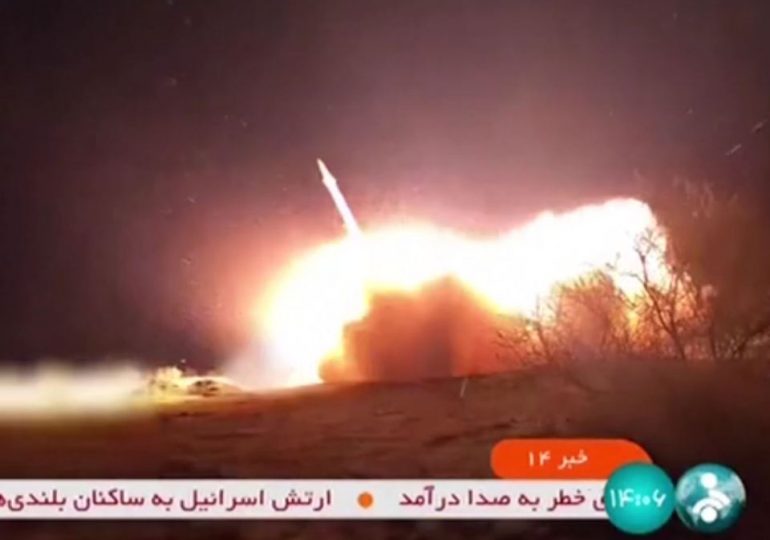RAF Top Guns helped down more than 300 drones and missiles as Iran threatened to trigger World War Three early yesterday.
At least four Typhoon fighters took out weapons bound for Israel after scrambling from RAF Akrotiri on Cyprus.
The moment Iran began its 300 drone and missile attack on Israel is revealed by state television
ReutersIsrael’s anti-missile system Iron Dome in operation as Iran attacks[/caption]
SWNSAn RAF Typhoon aircraft – like the one in operation last night – takes off to conduct air strikes against military targets in Yemen earlier this year[/caption]
ReutersExplosions are seen in the skies above Jerusalem on Saturday night[/caption]
It was the biggest air-to-air battle involving the UK since the Falklands in 1982.
PM Rishi Sunak confirmed the £73million jets shot down “a number” of drones launched directly from Iranian soil late on Saturday.
They locked on and downed them before they reached towns and cities.
Allied warplanes and Israel’s “Iron Dome” missile defence system took out 99 per cent of the threat.
Mr Sunak condemned Iran’s attack as “reckless” and called for calm.
He added: “I want to pay tribute to the bravery and professionalism of our pilots flying into the face of danger to protect civilians.
“If this attack had been successful, the fallout for regional stability would be hard to overstate.
“What we now need is calm heads to prevail.
“Iran has again demonstrated it is intent on sowing chaos in its own backyard.
“The UK will continue to stand up for Israel’s security and that of all our regional partners, including Jordan and Iraq.
“Alongside our allies, we are urgently working to stabilise the situation and prevent further escalation. No one wants to see more bloodshed.”
Foreign Secretary Lord Cameron said he “formally condemned the attack in the strongest terms” in a call with his Iranian counterpart Hossein Amir-Abdollahian.
Mr Sunak chaired a Cobra meeting on Friday to agree a plan of action after intelligence warned a massive attack was imminent.
Defence sources revealed UK jets were airborne for several hours and backed by refuelling tankers as they picked off drones over Iraq and Syria before they reached Israel.
A source said: “It is incredibly complex when you have so many missiles and drones coming from so many different directions, plus different allies with different assets, aircraft, missiles, on hand to help. But that is exactly what Nato allies train to do together, all the time.
RexA drone is launched at Israel from an undisclosed area in Iran[/caption]
Luca Boffa / No 10 Downing StreetRishi Sunak was briefed by staff before holding a call with leaders from the G7 nations[/caption]
What is Israel’s Iron Dome & how does it work?
ISRAEL’S air defence system is one of the best in the world having successfully intercepted thousands of rockets.
The mobile all-weather Iron Dome is at the forefront of that and was central to fending off Iran’s recent missile and drone attack.
Here’s the lowdown on the high tech system.
What is Israel’s Iron Dome?
Iron Dome is a counter rocket, artillery, and mortar (C-RAM) short range air defence system.
It is designed to intercept and destroy short-range rockets and artillery shells fired from distances of 2–43 miles away.
It intercepts rockets that are travelling in the direction of urban areas and brings them down – the first system of its kind in the world.
Israel hopes to increase the range of the dome’s interceptions to 250km and make it able to stop rockets coming from two directions.
Developed by Rafael Advanced Defence Systems and Israel Aerospace Industries, it can be operated in all weather conditions including fog, dust storm, low clouds and rain.
From 2011 to 2021, the United States contributed a total of $1.6billion to the Iron Dome defence system, befor another US$1billion was approved by the US Congress in 2022.
How does it work?
The dome is made up of missile batteries which are shaped like giant match boxes and are tilted in the direction of Gaza.
The Iron Dome monitor detects a target using radar and monitors its trajectory.
A control centre then calculates an interception point and then commands a rocket to launch if the foreign missile is heading towards an urban area.
Once in contact with the missile, the rocket explodes and brings it down.
Each launcher contains 20 Tamir Missiles with proximity war heads and there are several batteries positioned around the country.
Since being implemented in 2011 the computer systems have been updated, improved and upgrades to improve the accuracy of the rockets.
“It has been pretty intense over the last few days of preparation.
“The Americans pulled the plan together.”
Middle East experts last night said peace remained on “a knife-edge”.
Analysts predicted Israel PM Benjamin Netanyahu will hit back hard as he held talks with his war cabinet.
But US President Joe Biden is understood to have pleaded for a measured and proportionate response to draw a line under the crisis.
Earlier, discussing the attack, Mr Biden said: “Israel demonstrated a remarkable capacity to defend against and defeat even unprecedented attacks –— sending a clear message to its foes that they cannot effectively threaten the security of Israel.”
AlamyMiddle East analysts predict Israeli PM Benjamin Netanyahu will hit back hard[/caption]
ReutersIsraeli Air Force F-15 Eagle is pictured at an air base after an interception mission of an Iranian drone and missile attack on Israel[/caption]
Free for editorial useFootage taken from an RAF Typhoon PoOD shows a targeted strike against two Houthi military targets in Yemen[/caption]
How simulations predict Iran v Israel would play out
How Israel’s Iron Dome works
I WAS IN JERUSALEM HOTEL WHEN IRAN LAUNCHED ITS ATTACK
By David Ross, Head of Video for The Sun, in Jerusalem
THE ALERTS came through on our phones after we arrived back at the hotel in central Jerusalem.
Like many others, we headed to our room knowing that Iran had just launched hundreds of drones and ballistic missiles in our direction.
Then, at 2am, we heard two enormous booms, followed soon after by emergency sirens.
Every Israeli knows the drill but for my wife Jess and I, it was the first time we’d experienced anything like it.
They call it terror for a reason: because it is terrifying. There’s a bizarre adrenaline rush too.
You don’t have no time to think and you act on instinct.
It’s about grabbing any clothing you can and dressing as you quickly move to the safety of a shelter.
We headed below ground to Level -4 and remained there as the sirens continued to blare all around us.
After what felt like a lifetime – but was probably only 20 minutes – we were given the all-clear to return to our rooms.
Our hearts were racing as the footage of what was happening overhead exploded over X and the TV news channels.
We huddled together, glued to the latest developments.
By the time it was all over, the Israel Defence Forces managed to intercept 99% of the drones and surface-to-surface missiles.
A combination of the Arrow Aerial Defence System, the Iron Dome, Israeli aircraft and warplanes from the UK and US had saved countless lives – ours included.









